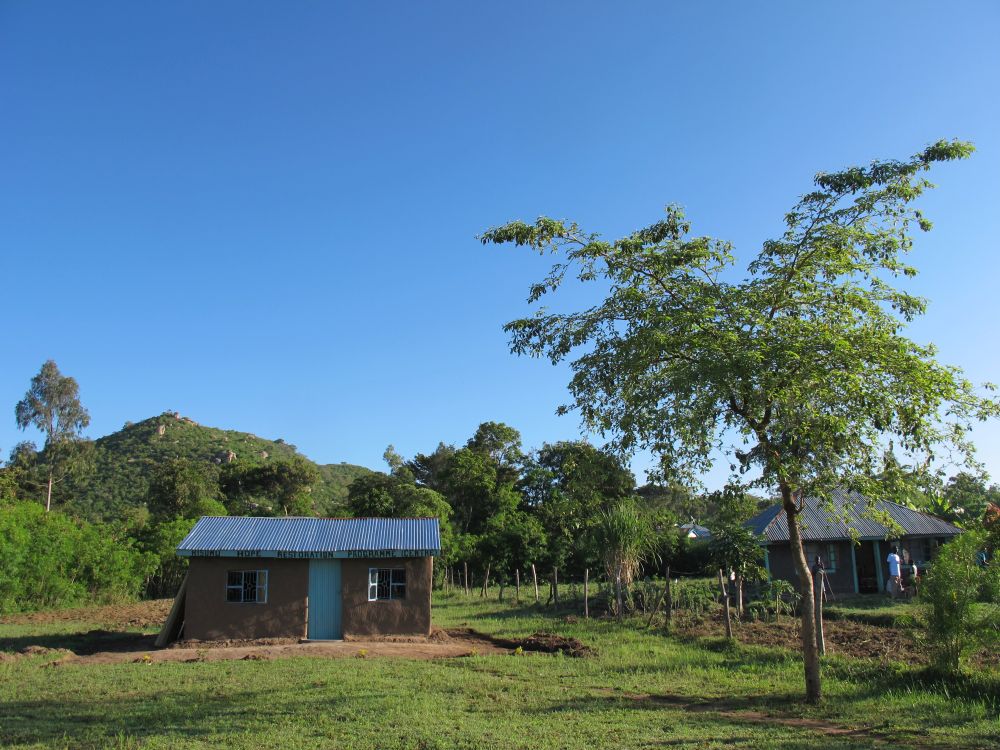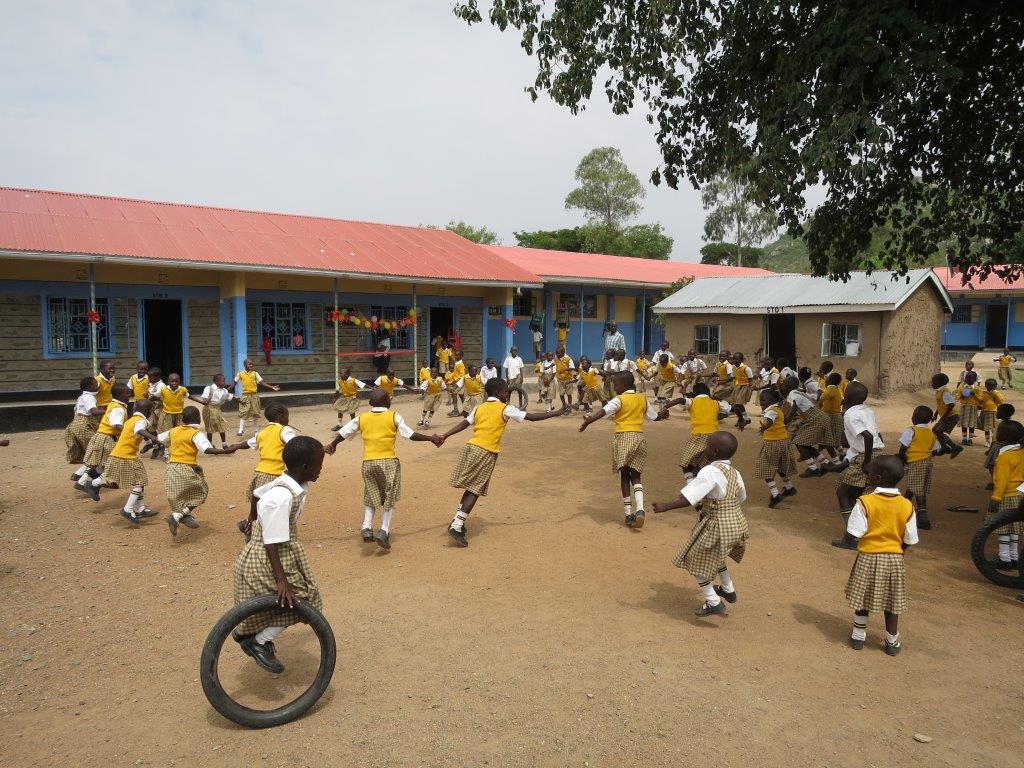Albert Schweitzer School in Kisumu County, Kenya
“Who among us has ever heard about this? The school is closed because of the Corona Crisis, but the students just don’t want to go home!”
Andrea, a good friend of ours, told me about an organisation she supports in Kombewa in Kisumu County in Kenya. She describes photos in which students can be seen standing in the shade of a tree looking thoughtful. They are familiar with viruses, many of their parents had died, they were HIV positive. A quarter of the region’s population is HIV positive. The many AIDS deaths leave countless AIDS orphans behind. But the Corona virus is something completely new and scary. Although there are only 25 recorded cases in Homa Bay County, the world seems to be going crazy. This is not comprehensible to the children or adults there.
Steve Onyang, a kanthari graduate from 2013, has taken care of these very orphans. First, he took in the children of his relatives. Then, before he came to the kanthari Institute, he and his wife Rosemary started Hope Restoration Centre, a home for AIDS orphans. During the kanthari program he developed his idea to start a primary school for orphans. The children should, if possible, grow up with their grandparents or other relatives and come to his school.
A year later, in the spring of 2014, we set out to visit Steve and Rosemary in their project. We were four. Marijn Poels, a well-known Dutch documentary filmmaker (http://www.marijnpoels.com/) Tomek, a Polish kanthari participant from Steve’s batch, who had set himself the goal of documenting kantharis and their activities with short video films, and both of us, Paul and I. I was just writing my fourth book. This time it would be about kanthari and the different initiatives of the participants. For this we visited some of the graduates in their far-flung villages.
Here is a small excerpt about our trip to Steve, to Homa Bay County:
“Potverdomme! What a driver!” We are crammed in the backseat of an ancient taxi, to the left of me Tomek, a kanthari graduate, who was lost for words during this frenzy, and next to me Marijn, who occasionally hurled some Dutch curse words. To the right of me is the car door, but I am not quite sure whether it is properly closed or is just held in place by the wind.
Paul had long tried to negotiate the outrageous price that the driver wanted. The drivers reasoning: we should understand that it is very late, that his grandmother is dying, that he has to drive the long way back to the city all by himself – and that the night is sooo dark!
Paul finally gave up; indeed, it was really late, and we were very very tired. When we managed to get all luggage as well as ourselves into the car, we started, African rap songs blared from crackling loudspeakers, accompanied by a rather disturbing squeaking sound of the tailgate. But it wasn’t until we were on the road that we understood what the driver meant by saying that the night was soooo dark!
Marijn shouted out… “Shit man, he is driving without headlights!” Suddenly, my travel partners were all right awake. Everyone was protesting. When the driver didn’t react, Paul tried to illuminate the road from the passenger seat with a small flashlight, but that didn’t really make a difference! It must be said that many of the trucks that are approaching us also drive without light. They look like massive cannon balls coming out of nowhere in front of an equally dark, cloud-covered night sky.
“We’ve survived a lot of bad drivers,” Paul said, “but this one is too wild even for me now.”
Marijn and Paul forced the driver who initially didn’t want to stop. With improvised tools they managed to fix one of the headlights. With half luminosity, but double speed, the journey continued.
I felt tense, I didn’t know what was really going on. Only later my fellow passengers told me how the driver kept his head out of the window at a speed of 80 kilometres per hour on the narrow country road. It wasn’t entirely clear whether to cool down or to have a better view of the road ahead. During his actions, the vehicle hurled back and forth and when we hit bumps, we were literarily flying. Fortunately, I didn’t think the bumpy ride was caused by the driver and the excessive speed, but only due to poor road conditions.
After an hour of continuous tension, we left the ‘expressway’ and, now still at a breakneck pace, we bumped through an even darker jungle, which seems to be closing in on us from both sides. Foliage, shrubs and branches scraped along the doors and whipped the roof of the car. We slithered and rumbled from pothole to pothole, and every now and then the vehicle stopped as if it had driven into a wall.
“Be sure you don’t run over an elephant!” Paul joked.
But the driver’s reply was humorless and a little dull: “There are no elephants here, only hyenas and leopards.”
And then finally out of nowhere Marijn shouted: “Wow, the moon! A village!” As if we had finally come upon civilization after weeks of touring the wilderness, Marijn exclaimed in delight: “Jambo! The beauty of Africa!”
We arrived in Seme, a small village somewhere in the bush. It was in the middle of the night, but no one seemed to sleep here. Dogs barked, children were dancing, everyone wanted to see us, the Mzungus, the white-folks with whom “Uncle Steve” had spent a whole seven months in southern India. Uncle Steve, father of five children of his own and twenty AIDS orphans, was obviously the most respected person in the village. Although he was not the oldest, everything he says in a lively, almost youthful voice to the scurrying villagers was done immediately. A few words in Luo, the local language, and hands stretched out from everywhere to receive our luggage. In a crowd of children, calves and cows, we walked across a meadow to the building complex of the orphanage. Well… Complex? The home consisted of a collection of smaller and larger huts, a smoky kitchen hut, stables that smelled of cattle and fresh hay, and a rather smelly easy-to-identify latrine, which would probably not to be missed even in the darkest nights. But on this night, the moon illuminated the narrow path, which winded along small pools home to loud frogs, leading directly to the main hut.
(From “The Dream Workshop of Kerala.”)
Over the last few years, this very minimalist home complex has been transformed to this:
Today his project is called “Albert Schweitzer School, Kenya”, a school with 200 students.
How did this happen?
In 2013, at the kanthari Institute, Steve met our friends, the Schweitzer Munz family.
Andrea Munz, who as a first-time visiting catalyst, had caught the kanthari bug and in the years to come, returned to kanthari again and again. As a graduate psychologist, she offers workshops in the field of communication and therapeutic storytelling and she is an indispensable help in preparing participants for the kanthari Talks, our annual dream speech festival.
Her parents, Walter and Jo Munz also visited in 2013. Walter was the direct successor of Albert Schweitzer and headed the famous clinic in the jungle of Gabon, West Africa, for more than ten years.
All three became friends with Steve and over the years the first Kenyan Albert Schweitzer school was born. Andrea Munz heads the relevant foundation in Switzerland and visits Steve every year.
During the last few weeks, I tried to reach Steve again and again, but internet access in his region is limited, and to call me on the phone he had to travel 40 km to Kisumu. So, Andrea told me about the current situation.
When the government decree came to close all schools, Steve and his team wanted to adhere, but the children stayed. After repeated requests to go back to their grandparents and relatives, it became clear to them what was happening. They were afraid that they would not get enough to eat staying with their relatives. At the Albert Schweitzer School, every child gets breakfast and lunch.
The whole team decided to stay. They cooked together, and the children were divided into small groups to bridge the time between the two meals through playing games and storytelling.
We have often wondered that our kanthari participants, who start schools or training centers in African or Asian countries, add as much importance to meals as the Curriculum. Today, however, the virus makes it clear how priorities need to be set.


